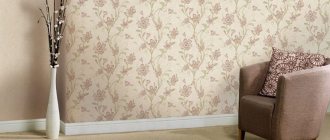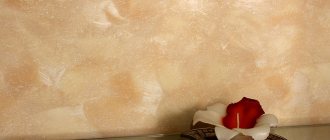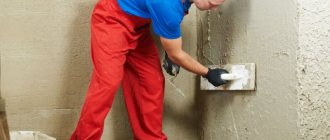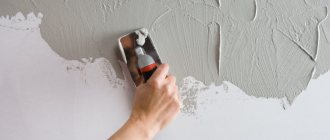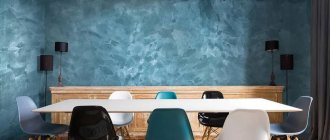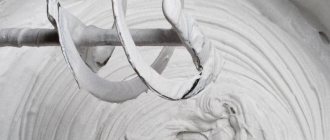What is silk plaster, how to apply it correctly, features of preparatory work and much more you will learn at remontlegco.ru from the detailed and step-by-step instructions given below.
Related articles:
How to plaster walls with your own hands.
Wallpapering walls.
What is silk plaster
Decorative plaster wet silk is a type of liquid wallpaper; it has the effect of a velvet wall covering, which is why it is also called velvet plaster.
The composition includes artificial silk fibers, cotton particles, cellulose and water-soluble glue. To add beauty, uniqueness and a glowing effect, mother-of-pearl particles and sparkles are additionally added to the “wet silk” plaster.
Silk plaster is a fairly new finishing and decorative material for walls and ceilings. Due to its spectacular appearance, ease of preparation and application technique, it is in high demand.
Silk plaster is sold in the form of a dry mixture or ready-made plaster paste and has a large number of colors and shades.
Where is it best to use this coating?
The uniqueness of the decorative coating wet silk allows the material to be applied to both horizontal and vertical surfaces. These rooms create a special atmosphere:
- corridor;
- hallway;
- children bedroom;
- study;
- home library.
On a note! Silk material allows you to turn any design idea into reality. A favorable and comfortable environment is created in the house.
Advantages and disadvantages of silk coating
Silk plaster is suitable for both apartments and office premises. It has many advantages over other decorative wall finishes, and they far outweigh the disadvantages.
Advantages of silk plasters
- suitable for walls and ceilings;
- high decorative qualities;
- ease of preparation and ease of application with your own hands;
- environmental safety, do not contain harmful substances that affect human health;
- non-toxic, odorless, but they absorb foreign odors well;
- you can hide small irregularities;
- fireproof;
- resistant to cracking, well suited for new buildings;
- you can create a variety of patterns;
- the result is a seamless coating, no joints or seams;
- easy to remove and repair;
- reuse is allowed;
- does not fade, can retain its original appearance for up to 10 years.
Flaws
- is a “collector” of dust;
- cannot be washed or exposed to high humidity, not suitable for the bathroom.
Popular manufacturer
High-tech Silk Plaster products are very popular, as they are made from environmentally friendly materials. Even a freshly applied coating does not have a pungent odor, which eliminates the need to move to another home during the renovation.
Comparison of Silk Plaster products with other types of finishes.
Types and features of silk plaster
Decorative plaster with silk effect is sold in two types:
- dry mixture;
- ready-made liquid plaster.
To prepare silk plaster from a dry mixture, it must be diluted with hot water. Its base is swollen cellulose.
The resulting mixture is applied to the wall in a thin layer and smoothed, removing defects. After drying, you will get a silky, velvety surface.
Ready-made liquid plaster with a silk effect can be applied immediately. It has a paste-like consistency.
The binding material is transparent acrylic, and for beauty, pearlescent powder, metal powder and crushed fibers are added.
After hardening, the material becomes like wet silk.
You can give silk plaster different colors using tint.
The composition of silk plaster is similar to Venetian plaster. But Venetian plaster is polished with protective wax after application, but silk is not.
Compound
Decorative plaster wet silk contains:
- acrylic;
- cellulose;
- polyester;
- silk fibers;
- cotton;
- additionally: mother-of-pearl, glitter, non-ferrous metal powder.
Manufacturers
The range of silk-effect plasters on the modern building materials market is so wide that such diversity causes certain difficulties in choosing the necessary solution. You should only trust proven companies that have been occupying their niche for a long time. Although in each case there are exceptions to the rules. These manufacturers occupy leading positions in the global market:
- Senedeco (France).
- Silkot (Japan).
- Bayramlar (Türkiye).
- San Marco (Italy).
Among domestic companies, the Optimist-Elite trademark stands out. The Russian manufacturer specializes in the production of plaster under the sonorous name “Silk Road”. The material is odorless, does not contain toxic compounds and is fireproof.
Another domestic brand, Silk plaster, is also in wide demand. Plaster from the manufacturer is of high quality, has a rich color palette and different textures. Moreover, plaster is available to most consumers due to its affordable price.
Required Tools
Before starting work, you need to prepare all the necessary tools, namely we will need:
- a spatula with rounded edges so as not to leave furrows;
- trowel - the size must correspond to the pattern and surface area;
- primer;
- roller;
- container (basin) for mixing the solution;
- ladder;
- water;
- rags.
If the amount of work to be done is large, then a drill with a special attachment for mixing the solution is needed.
Wet silk paint with pearlescent effect
The pearlescent shade will add luxury and sophistication to the interior. Unobtrusive mother-of-pearl will emphasize the visual depth of color, as well as its multidimensionality. In this case, the technique of applying the material and operating the coating will be as simple as in the case of the previous version. Pearlescent decorative paint from Decorazza - Seta da Vinci, which is economically used (only 200 grams per 1 square meter!), provides improved coverage and allows for wet cleaning. This is guaranteed by a high-quality binder and special additives included in the material.
Preparing the working base
One of the important stages of applying plaster is preparing the surface for work; the final result will depend on this. Preparatory work may vary depending on the surface material.
- It is necessary to clean the base from old decorative coating, wallpaper, paint, whitewash. Grease and dirt can soak into the finish and show up as unsightly stains. Paint the metal parts, otherwise rust will appear.
- the old plaster and remove crumbled fragments. Clean off dust and remaining dirt with a rag, seal cracks and smooth with gypsum putty.
- Wood and drywall seal defects and completely putty.
- Seal the cracks and putty in the concrete
- If there is fungus or mold, they must be completely cleaned, treated with an antiseptic and puttied.
Primer
The base must be completely dry.
For maximum service life of silk plaster, a primer with quartz chips is best; after drying, it creates a rough crystal lattice.
Using a roller and brush, the surface is generously coated with a deep penetration primer. After drying, you need to prime it again.
The primer can be tinted in a color that matches the color of the silk plaster.
Repair work can be continued only after the primer has completely dried.
If there is no primer, it can be replaced by mixing 3 parts water-based paint and 1 part PVA glue.
To keep the floor clean, it must be covered with plastic film.
Types, textures, composition and colors
The basis of the material is silk fibers, which not only provide a unique texture, but also give the mixture plasticity. The binding component is acrylic copolymers, which guarantee the strength and elasticity of the coating. The composition of silk plaster also includes:
- cellulose, polyester or cotton fibers;
- quartz chips;
- water-soluble glue flakes;
- plasticizers;
- modifiers;
- glitters and pigments;
- antifungal additives.
Components that make up silk plaster
Expensive versions of liquid silk may include unique fillers that give the mass translucency. In this case, the plaster will look different when viewed from different angles. Some brands of material contain other additives: stone chips, dust, mica. Cellulose, cotton and polyester are used to reduce the cost of plaster, because the more silk fibers it contains, the more expensive it is.
Depending on the effect, the following types of plaster can be distinguished:
- wet silk;
- crushed silk;
- smooth silk.
As for texture, stores most often sell stone-like compositions, imitation wood and Venetian plaster, as well as “broken glass”, “broken stone”, “raindrops”. The shine of the material is given by particles of mother-of-pearl, due to which the finished coating looks voluminous.
Decorative coating Wild silk for interior work
The color palette of plasters is incredibly rich and includes both basic (basic) tones and the most unusual shades. Neutral colors remain the most popular:
- beige and milky;
- silver;
- gold;
- peach;
- grey;
- blue;
- pinkish.
Liquid wallpaper of various colors in packaging
Users also often choose coatings in mint, olive, coffee, lilac and turquoise colors. Light colors can be successfully combined with more saturated ones, for example, highlighting one wall or a certain area with bright colors. Of the dark shades for this finishing material, designers recommend using terracotta, blue, purple, burgundy, green, and orange.
How to prepare decorative plaster
When the working surface is completely ready for further work, we begin to prepare a solution of silk plaster. Preparation of the mixture consists of several stages:
- Take warm water (30-350C) and pour it into a clean container according to the proportions indicated on the package.
- First we pour out the contents of small bags; these are various additives, usually glitter. Let stand for 5-10 minutes for swelling.
- Pour in the remaining plaster mixture and mix with your hands, after wearing rubber gloves. Various technical devices cannot be used, as the structure of the liquid wallpaper may be destroyed.
- Knead to a homogeneous consistency with the thickness of sour cream and leave to swell, according to the instructions.
In cold water, the glue may not dissolve completely, but in hot water it will curl up and lose its properties.
The preparation of decorative plaster wet silk from a dry mixture must be fully described on the packaging; strictly follow all recommendations and proportions.
If you have prepared too much mastic, put it in a plastic bag and seal it tightly. In this form, silk plaster will retain its original properties.
If the finished mixture has dried out, moisten it or add it to a new batch.
Scope of application
Silk decorative plaster is intended only for interior work and finishing of premises that meet certain requirements. This is due to the fact that the finished surface has low hydrophobicity (absorbs moisture from the air), is easily impregnated with foreign odors, and is sensitive to mild mechanical influences.
Due to these characteristics, silk decorative plaster can be used in heated premises of residential, office, public or other purposes. The only exceptions apply to the following:
- Kitchens and other premises intended for food preparation. Smoking areas and anywhere where there is a lot of smoke and pungent odors that can penetrate deep into the pores of the material.
- Bathrooms, bathrooms, saunas, toilets, showers, and other rooms with high humidity.
- Warehouses, utility rooms of industrial and commercial enterprises - where there is a high probability of damage to the integrity of the surface as a result of accidental contact with a hard object.
Healthy! For all other premises, the use of wet silk decorative plaster is allowed.
Decorative plaster on the wall Source pro100stroy.com
How to apply decorative plaster wet silk with your own hands
At this stage of work, you should already have prepared the surface that we will cover and the silk plaster should be ready for use.
Technique for applying decorative finishing.
Apply the initial base coat in a thin and even layer. To do this, take the plaster mixture with a trowel or hand, press it against the wall and smooth it out with the trowel at an angle of 10-15°.
The layer should be about 2 mm thick. If there are any lumps, remove them with a spatula and immediately level the area. Align and smooth the corners using a narrow spatula.
After 1-2 hours, smooth the dried plaster using a grater moistened with water.
The evenness of the decorative coating can be checked with a lamp by bringing it to the wall from different sides.
For complete drying, it takes 1-2 days at a temperature of at least 15°C. Heaters can be used to speed up drying.
Features of the composition
The performance properties and manufacturability of a material largely depend on its base. are distinguished :
- Silicone paint. It is suitable for facade and interior work. The coating forms a vapor-tight layer that is resistant to external influences.
- Silicate paint. Has increased resistance to negative influences. When using a primer, it should be taken into account that it must be similar in composition to paint. The main disadvantage is the high price compared to other texture dyes.
- Mineral base. The paint is sold in dry form (powder) and is most often used for outdoor work. This is the most economical option. The composition includes cement and lime.
- Acrylic paint. One of the most common options. It is sold in finished form, but there are options that allow the introduction of ingredients to create additional effects and colors.
The type of filler components is important. They affect the consistency of the paint and the size of the relief
Taking this factor into account, the following types of paint are distinguished:
- with crushed gas silicate;
- with granite or marble grains (crumbs);
- with metal inclusions providing a reflective effect;
- filled with quartz sand;
- fiber filling (synthetic or natural);
- with wood sawdust;
- with shells to give a pearlescent effect.
In particular, glitter and various drop-shaped and scaly particles are popular. To thicken the mass, modified starch is often introduced.
The height of the relief and its expressiveness depends on the size of the introduced particles. According to this parameter, paints are divided into the following types:
- Fine grain. The particle size should not exceed 0.5 mm.
- Medium grit. Particles with a size of 0.6-1 mm are used.
- Coarse grain. To create a high relief, particles up to 2-2.5 mm in size are introduced.
When choosing a textured paint, you need to familiarize yourself with its composition. The wall design style and relief pattern should be planned in advance. This will allow you to make a thoughtful choice of material.
How to make patterns and drawings
Using plaster with a wet silk effect, you can create not only a single-color decorative coating, but also various compositions, patterns and even multi-colored designs.
Any design or pattern made of silk plaster makes a special accent on the wall.
First of all, we decide on the future design or pattern. We draw or transfer it onto the wall using a stencil.
We prepare the plaster in sufficient quantity and in the required colors. You can go two ways: buy the required amount of plaster in different colors, but then there will be a lot of surplus left. It is better to choose a mixture of white color and add the desired shade with color.
We take plaster of one color and apply it with a spatula to all areas of the future pattern with this color. Smooth and adjust along the contour, removing excess.
We repeat these steps with all the colors until our drawing is completed.
With a very complex composition, you can simplify the work. First apply white “silk”, and only then paint it.
With this sequence, only oil or acrylic paints can be used.
Water-based paints cannot be used.
Crinkled silk effect
The technology for creating an imitation of crushed silk from decorative silk plaster is described below.
- We apply the initial base coat, having previously completed all the preparatory work.
- After complete drying, prepare the dry mixture according to the instructions or take ready-made silk plaster.
- Apply the mixture with a roller to a thickness of about 2 mm. If one person works, then the area of application of plaster at a time should be 1-3 square meters, otherwise it may harden before you have time to create a drawing.
- Using a special washer, we make various multidirectional movements: circular, figure-of-eight, etc., to get different curls.
- After creating the pattern in the first section, we again apply the working mixture next to it with a roller with a 3-5 cm overlap and treat it with a decorative washer. We repeat these steps until everything is finished.
Liquid wallpaper with silk
Liquid wallpaper with silk makes any room unusual and attractive. These wallpapers include:
- Cellulose. It performs a connecting function for all components of this type of coating.
- Fungicide.
- The adhesive base and plasticizer facilitate the process of applying such wallpaper.
- Silk fibers, both artificial and natural.
This is a composition that currently does not change and is present in all wallpapers of this type. To obtain the desired effect, fillers with a specific color are added to the mixture. You can mix glitter and other design components. As for the proportions that need to be observed, then this is optional - you can use as much as you consider necessary.
It is not difficult to make such a composition with your own hands. Special granules are purchased - this is exactly what all the components listed above look like together. The composition of the package is mixed with the amount of water indicated in the instructions. Alternatively, you can add glue, but due to its properties, cellulose provides an astringent effect. The resulting mixture must be allowed to brew so that it becomes homogeneous, this will make it easier and more convenient to apply it to the wall surface.
Liquid silk wallpaper is applied to the wall using the principle of putty. Masters recommend starting to work from the top corner and moving to the sides and down. For this process, it is better to take a spatula made of stainless steel, and the easiest way to level the applied material is with a plastic trowel.
Before applying wallpaper, the surface of the wall is prepared in the old fashioned way: if necessary, it is leveled, puttied, and primed. There is an opinion among craftsmen that before applying wallpaper you need to cover the surface with ordinary water-based paint. This will help increase the adhesion of the material and the wall surface.
The process of applying liquid wallpaper must be carried out step by step and nothing should be missed. The base must be white or transparent so that the shade of the already used material does not change.
How to apply silk plaster to a wall or ceiling
The technique of applying silk plaster is similar to applying simple plaster to walls or ceilings. Silk plaster can be applied in two ways:
- in one layer;
- in two layers.
Application in one layer of silk coating
Applying a decorative coating in one layer is the most simplified and easiest way.
Place the finished mixture on a trowel with a spatula and spread it with a layer of no more than 2 mm. The next portion of plaster is applied with an overlap on the one just laid.
Protruding elements on the wall are first outlined and then filled.
After applying silk plaster and before it dries, it can be given a different texture; for this, use:
- special washer;
- stamps;
- various sponges;
- ribbed roller or with other attachments;
- crumpled polyethylene, etc.
If adding additional relief is not provided, then simply polish the material using a washer (smoother).
Technology of applying “wet silk” plaster in two layers
Applying silk plaster in two layers is a more complex technology, but the result is similar to textured Venetian plaster.
Application technique
- Apply the first layer of silk plaster to the previously prepared and dried wall. We make the first stroke with a trowel and mastic, starting from the junction of the ceiling and the wall. Spread the material over an area of about 1 sq.m. at a time.
- We plaster the next square along the joint, the third will be under the first, then again we move to the top of the wall, etc. – it turns out to be a kind of ladder. The thinner the first layer, the better. The joints of adjacent squares should not be visible. Let it dry completely, the time indicated on the package.
- Apply the second layer with a short-pile roller or, similarly to the first, with a trowel: “ladder”, 1 sq.m. But after drawing the next square, we return to the previous one and give it a pattern using various movements: circles, herringbones, waves, zigzags, etc.
- After complete application and texture, we begin polishing. Using a special washer (trowel) or grater we smooth out the roughness and give it a pleasant shine. Let it dry for at least a day, or preferably several days according to the instructions.
- At this stage you can finish or apply varnish.
What is decorative silk plaster?
When determining what a silk plaster mixture is, the composition of the finishing material is taken into account. It contains silk, cellulose, cotton fibers, adhesive base, polyester, acrylic additives, modifiers, coloring pigments, antifungal fillers, etc. Some glitter mixtures add glitter, pearlescent and translucent granules. Some manufacturers include mica particles, stone chips or marble dust. You can make your own plaster using the necessary ingredients.
The mass has a thick consistency and is evenly distributed over the surface of wall panels and ceilings. A plaster solution is applied to imitate fabric using several techniques using tools (spatulas, rollers) in a thin or dense layer. When finishing, it is important to maintain the proportions of decorative material and liquid. The coating has a uniform texture without roughness and does not require additional leveling.
Silk decorative coating has the following features:
- The original texture of the finishing material. Visually, the coating looks more aesthetically pleasing than standard plaster.
- The coating is durable and has a dense consistency. The material hardens quickly when applied in a room with a temperature of +5...+35°C.
- The plaster mixture is intended only for interior finishing work.
- When applying wet silk, it is necessary to use thin-layer techniques; 3 mm of coverage is enough to achieve the effect of walls covered with fabric.
- The composition is applied in several stages using seamless technology, providing an even coating on different types of panels.
Silk-like plaster in the interior is used to decorate walls, ceilings, and floors.
Silk plaster looks impressive in the following rooms:
- living room;
- hallway;
- study;
- Bedroom;
- corridor;
- home library.
How to care for decorative silk
Silk plaster does not require any complicated maintenance methods; it is electrostatic and almost does not attract dust. If necessary, the surface can be carefully vacuumed with a brush so as not to damage the finish.
If you need to clean the area from more severe contamination, you can try using a rag soaked in soapy water. But remember that silk plaster does not like moisture and, if necessary, it is better to carry out repairs by replacing a separate section of the decorative coating.
If wet silk effect plaster is coated with wax or protective varnish, it can even be cleaned with abrasive detergents.
Features of decorative paint for walls with silk effect
As you already understand, decorative wall paint with a silk effect (wet silk) is essentially an acrylic emulsion that has a certain effect. Initially, wet silk is a dispersion of acrylic resins, special additives, to the point where micro particles with crystals are added to the composition, which at the finish will give a wonderful iridescent effect, reminiscent of fabric, velvet, velor (this mention can only be attributed to high-quality materials , usually foreign-made).
So, based on the above, we understand with you that all this is water-dispersion (water-based) paint with a silk effect.
And right away, we can highlight the first and very important advantage of this type of finishing material, the fact that it is water-dispersed, that is, based on water, where water also acts as a solvent. Aqueous compositions are non-flammable, generally do not evaporate harmful and toxic vapors with substances, are environmentally friendly and harmless to health, unlike compositions based on organic solvents.
Organic solvents include white spirit, solvet, acetone, technical alcohols, etc., which are excluded and are not used in the products we offer.
Those factories (Cap Arreghini, Flugger, Colorificio Sammarinese, Spiver, MP) that we offer have passed mandatory certification. All compositions have environmental certificates, which confirms their safety for use inside public and residential premises, as well as in children's, educational, and medical institutions.
The second plus, or this can be attributed to the advantage that silk decorative plaster has, is maintainability. If you accidentally scratched or chipped a section of the finishing coating somewhere, then you just need to lightly smear the scratch or chip on top or randomly apply the remaining material over the affected area with light movements.
Depending on how badly the surface was damaged, you should carefully level the damaged area, the depression, or at best you can get by with grease. If the chip is deep enough, you should fill it up using finishing putty, let it dry thoroughly, then carefully prime it with a deep-penetrating primer (without smudges - otherwise they will remain on the wall) and let the damaged area dry again.
Final local repairs should be carried out using the same compositions that were originally used during application, that is, the substrate and the decorative paint for walls with a silk effect. If you no longer have any material left, the remnants have been thrown away and you plan to purchase the composition for local repairs, then keep in mind that you risk getting a slight difference from the overall appearance, and most likely a slight discrepancy in color, especially this will be noticeable into the eyes, if the damaged area was in a visible place (this is the case with all dyes, be it automotive or interior, or decorative, etc.).
This property can only be attributed to high-quality products.
The third advantage and advantage is that silk-effect decorative plaster is not afraid of water, due to the fact that the main part of the materials is made from acrylic resins with polymers. After application and subsequent hardening, film-forming components (acrylic resins, polymers) form a dense film with a good hydrophobic effect.
Silk effect paint, which you can buy in our online store, meets the highest requirements for finishing materials of this type. It follows from this that wet silk plaster can be applied and used in rooms where there is moisture, that is, in bathrooms, toilets, kitchens, etc.
It should be mentioned as a separate advantage that decorative silk plaster from those factories that our online store offers prevents the appearance and formation of unwanted microflora, fungus, mold, etc.
The fourth advantage that wet silk decorative plaster is endowed with is its washable properties. So, since the main part of the components included in the composition are polymers of acrylic resins of the highest European quality, which after complete polymerization form a very strong film of the finishing layer, which is not only not afraid of water, but which can be easily washed, and in some cases, rubbed locally, without fear of damaging the coating.
You can even highlight several products offered by us, which are endowed with 1 (first) class of resistance to washing and abrasion. We can say that decorative silk plaster in this case belongs to the category endowed with anti-vandal characteristics.
Decorative wall paint with silk effect Esentia (silk plaster) from the Italian factory Cap Arreghini and wet silk Tango from the Italian factory Colorificio Sammarinese are endowed with all the above-mentioned properties. So, you can safely paint these products in any corner of your house or apartment, be it a children's playroom, kitchen, bathroom or just a living room. These products can withstand even mechanical stress without losing their appearance.
Plus, if you want to add additional wear-resistant characteristics, enhance hydrophobic and washable properties, give a more glossy or matte appearance to the finish coat, for this, manufacturers have provided special compositions in the form of protective varnishes for decorative and finishing surfaces.
Fifth, vapor permeability or ordinary words are breathable properties, which is also an important advantage of decorative silk plaster. This property allows moisture to remove excess or accumulated moisture from the base, thereby preventing the formation of mold and mildew.
Vapor permeability allows air to pass in both directions, thereby not creating the effect of polyethylene.
The sixth advantage of wet silk is the choice of color. Here you are not at all limited, except that manufacturers offer a limited selection of colors in their catalogues. But you can try to create the desired color yourself.
To obtain the desired color scheme, we recommend that you contact professionals or companies involved in the supply and sales of decorative and finishing products. The color can be selected from any catalog, any tinting system, be it RAL, NCS, Symphony or any others.
We strongly do not recommend that you try to mix colors yourself, since, unlike interior paint, wet silk paint has a translucent consistency and to obtain the desired color, pigments (a dye that is added in a certain proportion to the base to obtain the desired color) are added to a completely different proportions.
Also, you should pay attention to the fact that the selected color from the catalog of ordinary interior paint and varnish products will be different and perceived differently by the eye after you have tinted the wet silk base of the decorative plaster in the color you have chosen.
When applying material to a surface, you can use the technique of mixing several colors on one plane. You can take compounds of different colors and apply them to a trowel, after which you create the desired pattern and drag the trowel over the surface where the different colors mix.
Price is also a relative advantage, both of the work itself and of the compositions themselves. Decorative silk plaster, the price of which is much lower compared to the same wallpaper (in this case we are talking about high-quality wallpaper of European quality), plus you get a single wall without unnecessary seams.
And if you compare the price of wet silk plaster and the price of natural stone, and even artificial stone, then there will generally be a significant price gap. At the same time, installing stone will also cost a pretty penny compared to applying decorative and finishing materials.
Panels or decorative finishing materials. The panels are more expensive, do not allow steam to pass through, that is, do not breathe, and have joints and seams.
With all this, silk decorative plaster is much more practical and easier to apply than installing stone, gluing good and expensive wallpaper, etc., and requires less maintenance and cleaning costs...
It should be emphasized and noted once again that all of the above advantages and benefits of decorative wet silk plaster can usually be attributed to products only of foreign origin, usually Italy. Unfortunately, on the Russian market of finishing materials, there are a lot of products that classify themselves as “pseudo” foreign production or, as many indicate on the labels, are produced on foreign equipment (and what equipment can it still be produced on? If the country does not have its own production of high-precision, professional paint and varnish equipment and equipment for the production of high-quality decorative and finishing materials).
Also, sellers can tell you as much as they want, or even this information may be contained on the label with the jar, that the product was released and produced using foreign technology using imported raw materials. Let's start with the fact that for the production of decorative plaster, wet silk raw materials are imported (the question is what quality?!), after which here it is brought to its “mind” (diluted, mixed with cheap components, thinners) and you get an economical finishing option.
Can it be applied with a roller?
Yes, the second coat of silk plaster can be applied with a roller.
The first layer is done as usual, leave to dry.
The second is applied using a short-haired roller, also in squares, as when applying with a trowel.
When applying plaster with a roller, you get a “fur coat” that needs to be smoothed out with stretching movements. The longer the pile, the thicker the layer and the more difficult it is to form the required relief.
It is not recommended to apply silk plaster with a long-haired roller, as the result will not be a smooth silk surface, but a thick layer with a “fur coat” effect.
Tools needed to create the silk effect
To apply a high-quality silk coating to the walls, you will need special finishing tools:
- Brushes for applying primer.
- Large and small standard spatulas for applying the base layer.
- Venetian trowels for applying silk paint to the surface of walls and ceilings. For these purposes, it is recommended to use a transparent tool in order to be able to control the thickness of the applied layer.
- Textured and velor rollers, as well as sponges, thin art brushes and fine-bristled brushes for creating designs.
- Wet rags or wipes for periodic cleaning of the trowel.
Silk paint, the packaging of which contains marks indicating a finely dispersed structure, can be applied using a spray gun equipped with an air blower or compressor that creates the required level of pressure. Sometimes, instead of a spray gun, a spray gun or a powerful vacuum cleaner with reverse blowing is used.
Types of paints for San Marco silk
San Marco has four different materials that differ from each other:
- Cadoro is a classic silk with a soft pearlescent sheen and shimmer. The soft structure of the paint allows it to apply smoothly. Kadoro looks good in a classic design or with a washer; it is not suitable for more textured applications.
- Cadoro Velvet - looks good when applied with a trowel. Inside this paint there are small silver grains, making the wall more velvety, and small white veins appear in the texture of the paint, giving the wall a feeling of lightness.
- Cavenier - this material is suitable for walls with not very good preparation. The paint is thick and can cover minor flaws in the wall. Cavenier is great for applying with a sea sponge or roller, but it can also be used to achieve the effect of classic silk.
- Via della seta - this coating imitates the effect of velvet; the paint applies evenly, without leaving bright tints. Apply with a brush or spray gun.
Silk effect paint is an ideal choice for those who want to create a luxurious interior by adding a pearlescent shine to the walls. We can see all options for these finishing materials in our decorative coatings showroom. Our managers will also be able to advise you online on all issues related to the choice of decorative paint for San Marco silk. All photos are taken from the official group.

